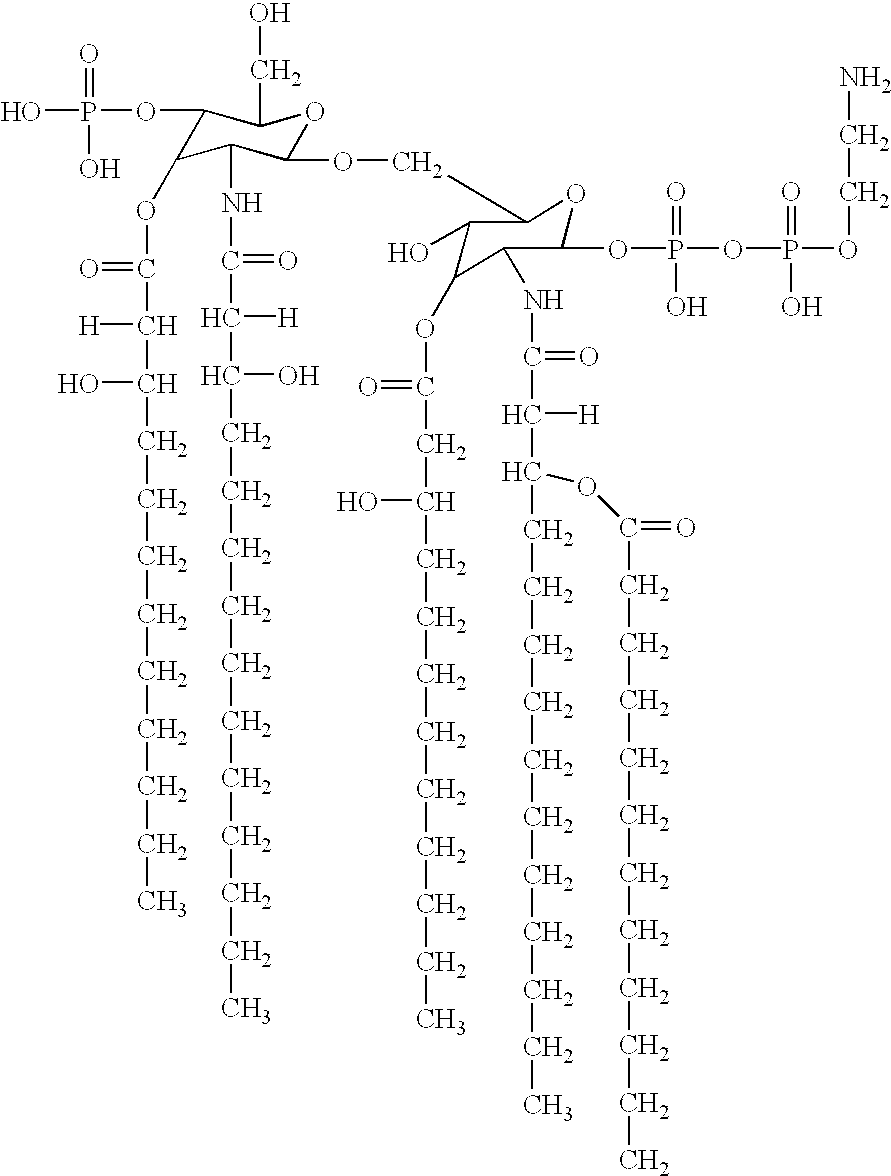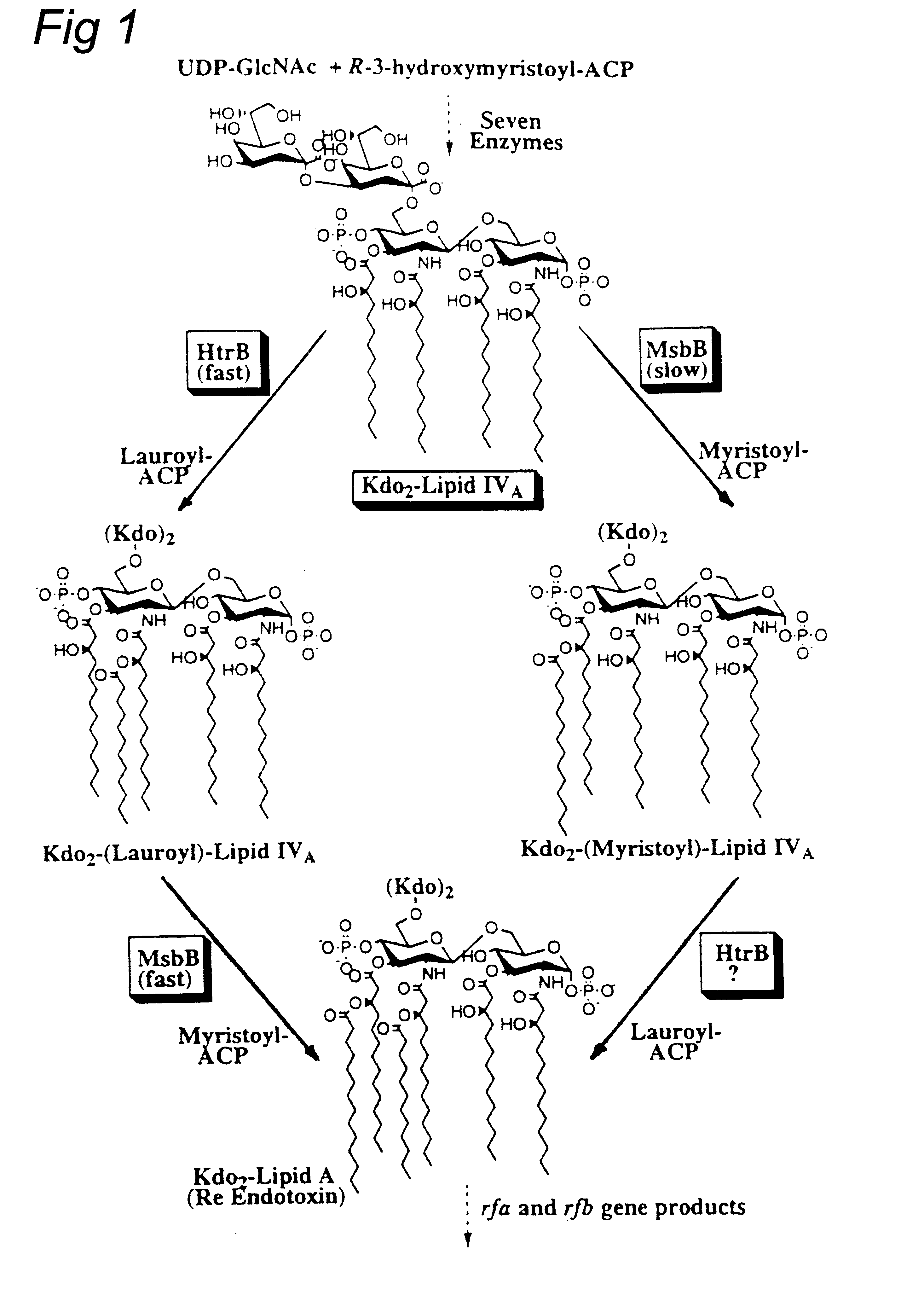LPS with reduced toxicity from genetically modified gram negative bacteria
a technology of genetically modified gram negative bacteria and toxicity reduction, which is applied in the field of vaccines, can solve the problems of not being able to provide uniform products at best, munford treatment cannot specifically remove secondary acyl chains, and b cell mitogenicity testing is not a reliable test to indicate adjuvant activity
- Summary
- Abstract
- Description
- Claims
- Application Information
AI Technical Summary
Problems solved by technology
Method used
Image
Examples
example 1
Construction of Neisseria Meningitidis Mutant htrB 1 with Altered Lipid A
Using the htrB / msbB gene sequences from Escherichia coli and Haemophilus influenzae, we performed a BLAST search on the gonococcal genome sequences made available on the Internet by the University of Oklahoma. Several contigs with significant homology were identified, and PCR primers were designed based on these sequences. With meningococcal chromosomal DNA as template, primers pr447-2 and pr670-1 gave a ca. 500 bp PCR product which upon cloning in vector pCRII and sequencing was found to be homologous to htrB / msbB sequences from several bacterial species (33% and 31% respectively for the E. coli genes). This fragment was used as probe for isolation of a larger chromosomal fragment containing the complete htrB1 gene of Neisseria meningitidis (FIG. 2). Immediately upstream of this gene an open reading frame with homology to the ruvC gene from E. coli was found, which presumably is involved in DNA repair and reco...
example 2
Structural Analysis of HtrB1 Mutant Lipid A
Fatty acid analysis by gas chromatography / mass spectrometry of whole cells showed a reduced ratio of C12:0 / C12:0 3-OH in the htrB1 mutant as compared to the wildtype parent strain, indicating a (partial) loss of the secondary C12:0 acyl chain(s). LPS from this mutant was purified through hot phenol / water extraction, and the lipid A fraction was obtained after acid hydrolysis and chloroform / methanol extraction. Its structure was subsequently investigated using tandem mass spectrometry. The analysis revealed a major penta-acyl species in which the C12:0 acyloxyacyl chain was missing from the nonreducing end of the molecule (FIG. 4).
An additional difference from the parent strain is found in the phosphorylation pattern at the reducing end of the disaccharide, where an additional phosphate group is present. This mutant lipid A molecule has a unique structure not found in any of the mutants described previously for other Gram-negative bacteria.
example 3
Biological Activity of HtrB1 Mutant LPS
Whole cells from mutant strain htrB1 were tested for their LPS-associated biological activity by both the Limulus amebocyte lysate (LAL) and tumor necrosis factor-a) (TNF-a) induction assays. In the LAL assay, a 7-fold reduction in activity was observed for whole cells from the mutant as compared to the wildtype. For TNF-a induction by MM6 cells, htrB1 bacterial cells showed at least a 100-fold reduction in activity as compared to the wildtype, similar to the reduction previously found for whole cells of a completely LPS-deficient mutant (FIG. 5) (L. Steeghs et al 1998). Immunization of mice with outer membrane complexes isolated from the LPS-deficient meningococcal mutant was used to compare the adjuvant activity of various LPS preparations. Antibody responses were measured in whole-cell ELISA and bactericidal assay against parent strain H44 / 76.
Immunogenicity of the major outer membrane proteins was restored to normal levels by both wildtype a...
PUM
| Property | Measurement | Unit |
|---|---|---|
| Pharmaceutically acceptable | aaaaa | aaaaa |
| Molecular structure | aaaaa | aaaaa |
Abstract
Description
Claims
Application Information
 Login to View More
Login to View More - R&D
- Intellectual Property
- Life Sciences
- Materials
- Tech Scout
- Unparalleled Data Quality
- Higher Quality Content
- 60% Fewer Hallucinations
Browse by: Latest US Patents, China's latest patents, Technical Efficacy Thesaurus, Application Domain, Technology Topic, Popular Technical Reports.
© 2025 PatSnap. All rights reserved.Legal|Privacy policy|Modern Slavery Act Transparency Statement|Sitemap|About US| Contact US: help@patsnap.com



